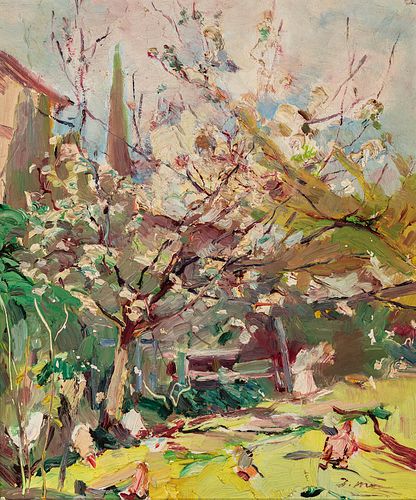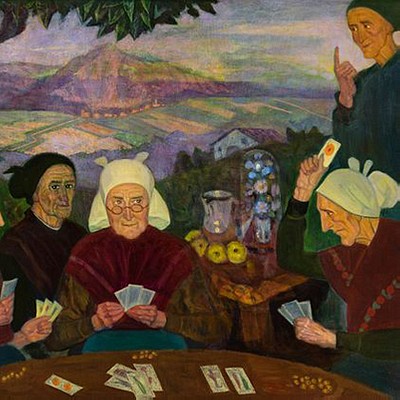JOAQUÍN MIR TRINXET (Barcelona, 1873 - 1940). "Landscape. Oil on canvas.
Lot 111
About Seller
Setdart Auction House
Carrer Aragó 346
Barcelona
Spain
Setdart Subastas was born in 2004 and is currently the first online art auction in Spain with solidity, prestige and reliability guaranteed by our more than 60,000 users. Setdart has a young, dynamic and enterprising team ready to successfully manage the purchase and sale of art works through custom...Read more
Estimate:
EUR€5,000 - EUR€6,000
$5,208.33 - $6,250
Absentee vs Live bid
Two ways to bid:
- Leave a max absentee bid and the platform will bid on your behalf up to your maximum bid during the live auction.
- Bid live during the auction and your bids will be submitted real-time to the auctioneer.
Bid Increments
| Price | Bid Increment |
|---|---|
| EUR€0 | EUR€10 |
| EUR€200 | EUR€25 |
| EUR€500 | EUR€50 |
| EUR€1,000 | EUR€100 |
| EUR€3,000 | EUR€200 |
| EUR€5,000 | EUR€500 |
| EUR€10,000 | EUR€1,000 |
| EUR€20,000 | EUR€2,000 |
| EUR€50,000 | EUR€5,000 |
About Auction
By Setdart Auction House
Dec 14, 2021
Set Reminder
2021-12-14 08:00:00
2021-12-14 08:00:00
America/New_York
Bidsquare
Bidsquare : 19th & 20th Century Fine Art
https://www.bidsquare.com/auctions/setdart-auction-house/19th-20th-century-fine-art-7992
Gaudi, Sorolla, Torres Garcia, Maclet, TSUGUHARU FOUJITA, Benjamin Palencia Setdart Auction House sofia@setdart.com
Gaudi, Sorolla, Torres Garcia, Maclet, TSUGUHARU FOUJITA, Benjamin Palencia Setdart Auction House sofia@setdart.com
- Lot Description
JOAQUÍN MIR TRINXET (Barcelona, 1873 - 1940). "Landscape. Oil on canvas. Signed in the lower right corner. Measurements: 45 x 37 cm; 58 x 48 cm (frame). In this work Mir demonstrates his absolute mastery of the technique and the capture of the landscape, in an image in which he manages to synthesize the naturalistic expression, the personal expression and the pictorial order. We see a sensitive brushstroke, which explores the space and gives it form and entity, creating volumes, lights and shadows, defining an atmosphere captured with great sensitivity. Through a purely personal language, Mir synthesizes the basic elements of representation and expressiveness of painting, as can be seen in the intensity of his colors or in the rigor of his compositional structure. Joaquín Mir studied at the Escuela de Bellas Artes de San Jordi in Barcelona and in the workshop of the painter Luis Graner. His style was also influenced by the School of Olot, his father's hometown. In 1893 he formed the "Colla del Safrà" together with artists such as Isidro Nonell, Ricard Canals and Ramón Pichot, and in the last years of the century he was associated with the artistic environment of "Els Quatre Gats". He completed his training in 1895, when he spent a season in Madrid copying works by Velázquez. During these years he took part in the Fine Arts Exhibitions in Barcelona in 1894, 1896 and 1898. Winner of a second medal at the Madrid Exhibition of 1899, that same year he moved to the capital in order to compete for a scholarship in Rome. When he was unsuccessful, he went with Santiago Rusiñol to Mallorca, on a trip that would be a definitive turning point in his career. Mir was dazzled by the Mallorcan landscape, specifically by the landscape of Sa Calobra, which was an inexhaustible source of inspiration for him. In 1901 he exhibited the fruit of this first Mallorcan period individually at the Sala Parés in Barcelona, and once again won a second medal at the National Exhibition. After a period of illness that forced him to move to Reus, in 1907 he won the first medal at the International Exhibition of Fine Arts in Barcelona. Already consolidated as an outstanding figure of the Catalan panorama, he acquires the definitive recognition at national level in 1917, when he is awarded the National Prize of Fine Arts. Four years later he married and settled permanently in Vilanova i la Geltrú. His successes followed one after the other, and in 1929 he won the first medal at the International Exhibition in Barcelona. The following year he won the medal of honor at the National Exhibition in Madrid, an award he had been pursuing since 1922. Although he was mainly a native painter, he had solo and group exhibitions in Washington, Paris, Pittsburg, New York, Philadelphia, Amsterdam, Buenos Aires and Venice. Mir is today considered the most outstanding representative of Spanish post-impressionist landscape painting. His work is preserved in the National Art Museum of Catalonia, the Prado Museum, the Thyssen-Bornemisza Museum and the Reina Sofia Museum in Madrid, among many others.
- Shipping Info
-
In-house shipping available. Please inquire at admin@setdart.com.
-
- Buyer's Premium



 EUR
EUR CAD
CAD AUD
AUD GBP
GBP MXN
MXN HKD
HKD CNY
CNY MYR
MYR SEK
SEK SGD
SGD CHF
CHF THB
THB















